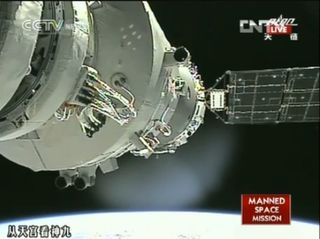
Three Chinese astronauts undocked their spacecraft from an orbiting robotic module Wednesday (June 27) and began preparing to return to Earth Thursday night.
China's Shenzhou 9 vehicle separated from the unmanned Tiangong 1 space lab Wednesday evening, according to China's state-run Xinhua news agency. The mission's three taikonauts, as Chinese astronauts are known, returned to Shenzhou 9 to begin the maneuver at 6 p.m. EDT (2200 GMT; 6:00 a.m. Thursday Beijing time).
The spaceflyers are expected to land around 10 p.m. EDT Thursday (June 28; 10 a.m. Friday Beijing time), Xinhua reported. Their touchdown, in northern China's Inner Mongolia autonomous region, will wrap up a historic mission that has marked a big step forward in China's ambitious space plans.
"Chinese astronauts have their own home in space now," Shenzhou 9 commander Jing Haipeng told Chinese president Hu Jintao during a congratulatory space call Tuesday (June 26), according to Xinhua. "We are proud of our country!" [Photos of Shenzhou 9 Mission]
Shenzhou 9 launched on June 16 carrying three taikonauts, including 33-year-old Liu Yang, the nation's first woman in space. The mission aimed to pull off China's first-ever manned space docking, and it succeeded — twice. The vessel hooked up with Tiangong 1 via remote control on June 18 and then again June 24 with the taikonauts at the wheel.
China thus became just the third country to performed a manned docking in orbit. The United States and Russia first accomplished the feat in 1966 and 1969, respectively.
Shenzhou 9's flight is testing technology and techniques needed to build a permanently staffed space station in Earth orbit. Chinense officials have said the nation hopes to have a 60-ton station up and running by 2020.
Get the Space.com Newsletter
Breaking space news, the latest updates on rocket launches, skywatching events and more!
For comparison, the $100 billion International Space Station weighs about 430 tons. The huge orbiting lab is run by a consortium of more than a dozen countries, but China is not among them.
China's space dreams don't end in low-Earth orbit. The nation has said it wants to return lunar samples to Earth with a robotic spacecraft by 2016 or so, and it plans to put a taikonaut on the moon sometime after the space station is built.
Shenzhou 9's other taikonaut is Liu Wang, 42, who steered Shenzhou 9 away from Tiangong 1 Wednesday evening. Jing, 46, also flew on China's last manned spaceflight, the Shenzhou 7 mission in 2008.
Shenzhou 9 is China's fourth manned space mission, with the other three flights coming in 2003, 2005 and 2008. The nation plans to launch another crew to Tiangong 1 soon, perhaps by the end of the year.
Tiangong 1 has been circling Earth since September 2011, and in November it linked up with the robotic Shenzhou 8 vessel, achieving China's first unmanned space docking.
Follow SPACE.com senior writer Mike Wall on Twitter @michaeldwall or SPACE.com @Spacedotcom. We're also on Facebook and Google+.
Join our Space Forums to keep talking space on the latest missions, night sky and more! And if you have a news tip, correction or comment, let us know at: community@space.com.

Michael Wall is a Senior Space Writer with Space.com and joined the team in 2010. He primarily covers exoplanets, spaceflight and military space, but has been known to dabble in the space art beat. His book about the search for alien life, "Out There," was published on Nov. 13, 2018. Before becoming a science writer, Michael worked as a herpetologist and wildlife biologist. He has a Ph.D. in evolutionary biology from the University of Sydney, Australia, a bachelor's degree from the University of Arizona, and a graduate certificate in science writing from the University of California, Santa Cruz. To find out what his latest project is, you can follow Michael on Twitter.
Most Popular


